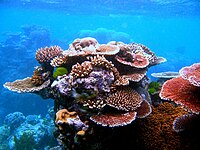
Photo from wikipedia
Abstract Fish have one of the highest occurrences of individual specialization in trophic strategies among Eukaryotes. Yet, few studies characterize this variation during trophic niche analysis, limiting our understanding of… Click to show full abstract
Abstract Fish have one of the highest occurrences of individual specialization in trophic strategies among Eukaryotes. Yet, few studies characterize this variation during trophic niche analysis, limiting our understanding of aquatic food web dynamics. Stable isotope analysis (SIA) with advanced Bayesian statistics is one way to incorporate this individual trophic variation when quantifying niche size. However, studies using SIA to investigate trophodynamics have mostly focused on species‐ or guild‐level (i.e., assumed similar trophic strategy) analyses in settings where source isotopes are well‐resolved. These parameters are uncommon in an ecological context. Here, we use Stable Isotope Bayesian Ellipses in R (SIBER) to investigate cross‐guild trophodynamics of 11 reef fish species within an oceanic atoll. We compared two‐ (δ 15N and δ 13C) versus three‐dimensional (δ 15N, δ 13C, and δ 34S) reconstructions of isotopic niche space for interpreting guild‐, species‐, and individual‐level trophic strategies. Reef fish isotope compositions varied significantly among, but also within, guilds. Individuals of the same species did not cluster together based on their isotope values, suggesting within‐species specializations. Furthermore, while two‐dimensional isotopic niches helped differentiate reef fish resource use, niche overlap among species was exceptionally high. The addition of δ 34S and the generation of three‐dimensional isotopic niches were needed to further characterize their isotopic niches and better evaluate potential trophic strategies. These data suggest that δ 34S may reveal fluctuations in resource availability, which are not detectable using only δ 15N and δ 13C. We recommend that researchers include δ 34S in future aquatic food web studies.
Journal Title: Ecology and Evolution
Year Published: 2022
Link to full text (if available)
Share on Social Media: Sign Up to like & get
recommendations!